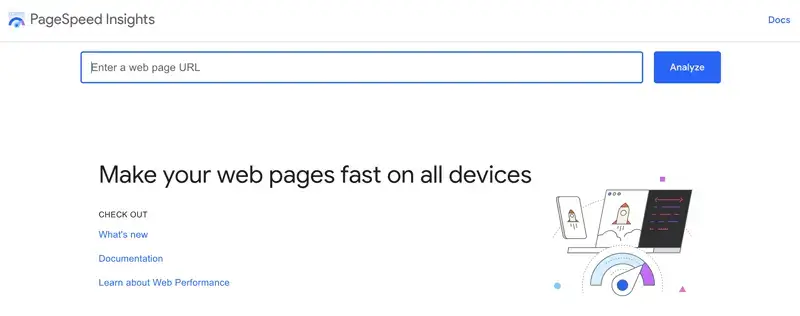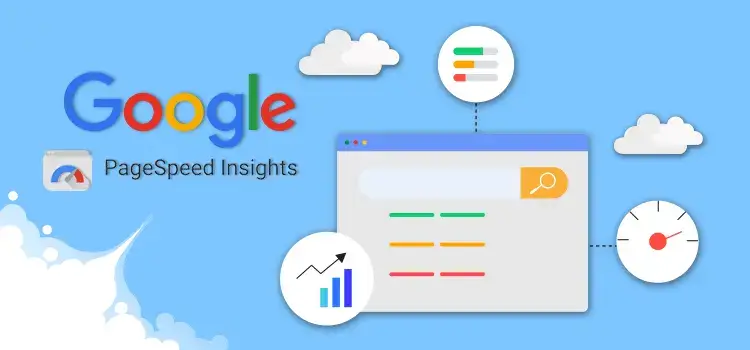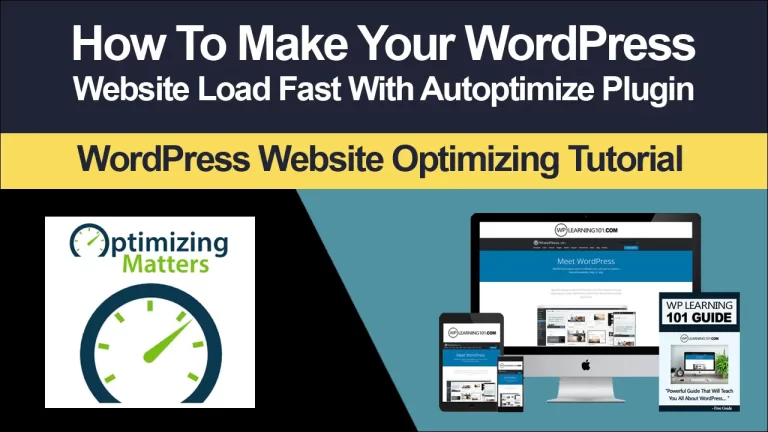How To Analyze Website Page Speed Using Google Pagespeed Insights

Beginners Guide: How To Analyze Website Page Speed Using Google Pagespeed Insights
How To Analyze Website Page Speed Using Google Pagespeed Insights: Website page speed is a crucial aspect of website performance. A slow website can lead to high bounce rates, lower search engine rankings, and lower conversion rates. Thus, it is essential to ensure that your website is optimized for speed. In this article, we will discuss how to analyze website page speed using Google Pagespeed Insights, a free tool provided by Google.
Introduction Website page speed is the time it takes for a website to fully load on a user’s device. It is an important factor that affects user experience and overall website performance. A slow website can lead to high bounce rates, which means users leave the website quickly, resulting in lower search engine rankings and lower conversion rates.
Google Pagespeed Insights is a free tool provided by Google that analyzes a website’s page speed and provides suggestions on how to improve it. The tool uses Lighthouse, an open-source performance auditing tool, to analyze a website’s performance and provides a report with a score and suggestions for improvement.
The purpose of this article is to provide a comprehensive guide on how to analyze website page speed using Google Pagespeed Insights and implement the suggestions to optimize website performance.

Setting up Google Pagespeed Insights
Google Pagespeed Insights is easy to use, and you can access it by visiting the following link: https://developers.google.com/speed/pagespeed/insights/.
To analyze a website, simply enter the website’s URL in the input field and click the “Analyze” button. The tool will then analyze the website’s performance and provide a report with a score and suggestions for improvement.
Understanding the Report
The report generated by Google Pagespeed Insights provides a comprehensive analysis of a website’s page speed and provides a score out of 100. The score is an indicator of the website’s performance, with a higher score indicating a faster website. The report also provides suggestions for improvement, which are grouped into the following categories:

- Optimize images
- Minimize HTTP requests
- Reduce file sizes
- Leverage browser caching
- Minify CSS and JavaScript
Key Factors Affecting Website Page Speed The following are the key factors that affect website page speed:
1. Image Optimization: Large images can significantly slow down a website. It is essential to optimize images by reducing their size and using appropriate image formats, such as JPEG or PNG.
2. Minimizing HTTP Requests: HTTP requests are made every time a website loads a page element, such as images or stylesheets. Minimizing HTTP requests can significantly improve website page speed.
3. Reducing File Sizes: Large files, such as CSS and JavaScript files, can significantly slow down a website. It is essential to reduce the size of these files by minifying and compressing them.
4. Leveraging Browser Caching: Browser caching allows a website to store frequently used files on a user’s device, reducing the time it takes to load the website. Leveraging browser caching can significantly improve website page speed.
5. Minifying CSS and JavaScript: Minifying CSS and JavaScript files involves removing unnecessary characters, such as whitespace, comments, and line breaks, to reduce their size. Minifying these files can significantly improve website page speed.
Interpreting Google Pagespeed Insights Report
Google Pagespeed Insights provides a comprehensive report with a score and suggestions for improvement. The following is an explanation of the report:

1. Explanation of the Score: The score is an indicator of a website’s page speed, with a higher score indicating a faster website. The score is based on several factors, including the time it takes for the website to load, the size of the website’s files, and the number of HTTP requests. A score of 100 indicates that the website is optimized for speed, while a score below 50 indicates that there is room for improvement.
2. Explanation of the Suggestions: The suggestions provided by Google Pagespeed Insights are grouped into the categories mentioned above and provide specific recommendations on how to improve website page speed. The suggestions include recommendations to optimize images, minimize HTTP requests, reduce file sizes, leverage browser caching, and minify CSS and JavaScript.
3. Understanding the Impact of Suggestions on Page Speed: Implementing the suggestions provided by Google Pagespeed Insights can significantly improve website page speed. It is essential to prioritize the suggestions based on their impact on page speed and implement them accordingly.
Optimizing Website Page Speed The following are the steps to optimize website page speed:
1. Implementing the Suggestions from the Report: The first step to optimizing website page speed is to implement the suggestions provided by Google Pagespeed Insights. It is essential to prioritize the suggestions based on their impact on page speed and implement them accordingly.
2. Testing the Website for Improvement: After implementing the suggestions, it is essential to test the website for improvement. This can be done by using Google Pagespeed Insights to analyze the website’s page speed and compare the new score to the previous score.
3. Continuously Monitoring Page Speed: It is essential to continuously monitor website page speed to ensure that it remains optimized. Regularly using Google Pagespeed Insights to analyze the website’s page speed and implementing the suggestions for improvement can help to maintain optimal performance.
Website page speed is a crucial aspect of website performance that can impact user experience, search engine rankings, and conversion rates. Google Pagespeed Insights is a free tool that provides a comprehensive analysis of website page speed and provides suggestions for improvement. The key factors that affect website page speed include image optimization, minimizing HTTP requests, reducing file sizes, leveraging browser caching, and minifying CSS and JavaScript. Implementing the suggestions provided by Google Pagespeed Insights and continuously monitoring page speed can help to optimize website performance.
References
- Google Developers, “Google Pagespeed Insights”, https://developers.google.com/speed/pagespeed/insights/
- Google Developers, “Lighthouse”, https://developers.google.com/web/tools/lighthouse/
- GTmetrix, “Website Speed and Performance Optimization”, https://gtmetrix.com/
- Moz, “Website Speed and Search Rankings”, https://moz.com/blog/website-speed-and-search-rankings
- Pingdom, “Website Speed Test”, https://tools.pingdom.com/
By using this information, you should now have a clear understanding of how to analyze website page speed using Google Pagespeed Insights and implement the suggestions to optimize website performance.

Here are some detailed bullet points that summarize the main points of the article:
- The importance of website page speed for user experience, search engine rankings, and conversion rates
- An overview of Google Pagespeed Insights as a tool for analyzing website page speed
Factors that Affect Website Page Speed
- The time it takes for the website to load
- The size of the website’s files
- The number of HTTP requests
- Explanation of a score of 100 in Google Pagespeed Insights indicating a optimized website
Explanation of Suggestions from Google Pagespeed Insights
- Grouping of suggestions into categories of optimization, such as images, HTTP requests, file sizes, browser caching, and CSS and JavaScript minification
- Specific recommendations on how to improve website page speed
Impact of Suggestions on Page Speed
- The significance of implementing the suggestions on improving website page speed
- The importance of prioritizing suggestions based on impact on page speed
Steps to Optimize Website Page Speed
1. Implementing the suggestions from the Google Pagespeed Insights report
2. Testing the website for improvement after implementing suggestions
3. Continuously monitoring website page speed to ensure optimal performance
Conclusion
- The significance of website page speed for website performance
- The value of using Google Pagespeed Insights to analyze and improve website page speed
- The importance of continuously monitoring page speed for optimal performance
References
- Google Developers’ website for Google Pagespeed Insights and Lighthouse
- GTmetrix website for website speed and performance optimization
- Moz’s website for information on website speed and search rankings
- Pingdom’s website for website speed tests
By following these detailed bullet points, you should have a clear understanding of the article and the steps involved in analyzing and optimizing website page speed using Google Pagespeed Insights.

Action Plan for Improving Website Page Speed
1. Run a website page speed analysis using Google Pagespeed Insights.
- Input your website URL into the Google Pagespeed Insights tool
- Review the results, including the score and suggestions for improvement
2. Prioritize the suggestions for improvement based on their impact on page speed.
- Review the suggestions provided by Google Pagespeed Insights
- Determine which suggestions will have the greatest impact on page speed
3. Implement the high-impact suggestions for improvement.
- Follow the specific recommendations provided by Google Pagespeed Insights
- Make the necessary changes to optimize images, minimize HTTP requests, reduce file sizes, leverage browser caching, and minify CSS and JavaScript
4. Test the website for improvement.
- Use Google Pagespeed Insights to re-analyze the website’s page speed
- Compare the new score to the previous score to determine the level of improvement
5. Continuously monitor website page speed.
- Regularly use Google Pagespeed Insights to analyze website page speed
- Implement further suggestions for improvement as needed
- Ensure that website page speed remains optimized over time
By following this action plan, you can effectively analyze and optimize website page speed using Google Pagespeed Insights. By prioritizing suggestions for improvement and continuously monitoring website performance, you can ensure a smooth user experience and improved search engine rankings.
Summary:
In today’s digital age, website page speed is a critical factor for user experience, search engine rankings, and conversion rates. Google Pagespeed Insights is a useful tool for analyzing website page speed, providing a score and specific suggestions for improvement. Factors affecting website page speed include the time it takes to load, the size of website files, and the number of HTTP requests. By implementing suggestions from Google Pagespeed Insights, prioritizing high-impact optimizations, and continuously monitoring website performance, website owners can improve website page speed and ensure optimal user experience and search engine rankings.
Conclusion:
Website page speed is a vital aspect of website performance that can have a significant impact on user experience, search engine rankings, and conversion rates. By using Google Pagespeed Insights to analyze website page speed, website owners can receive specific recommendations for improvement and optimize their website’s performance. The implementation of high-impact optimizations, followed by continuous monitoring, can ensure a smooth user experience and improved search engine rankings. With the proper analysis and optimization, website page speed can be a major asset for website success.







